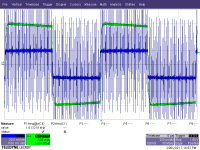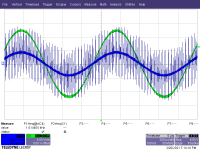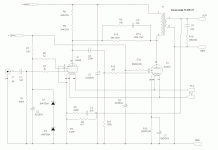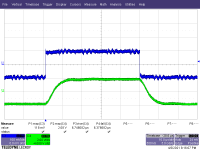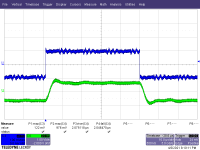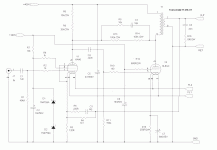Re the boost converter module - you get what you pay for, and only if you're lucky at that. I have always been suspicious of those sort of "wonder modules"
I fired my DC-DC converter up last night, and it works pretty much as advertised. After some tweaking, I plan to bias up the tubes sans transformers.
It would be interesting to reconfigure my DC-DC as a regulated push-pull boost converter. If I can work out the logic, I'll give it a go. It may be possible with creative use of the venerable TL494 controller.
I'll probably do initial work with the amp using the Edcor GXSE transformers originally used, but I also have my eye on a a pair of 7W, 5k transformers from Transcendar that could be tucked neatly out of sight in the box, incidentally keeping it from falling over....
I fired my DC-DC converter up last night, and it works pretty much as advertised. After some tweaking, I plan to bias up the tubes sans transformers.
It would be interesting to reconfigure my DC-DC as a regulated push-pull boost converter. If I can work out the logic, I'll give it a go. It may be possible with creative use of the venerable TL494 controller.
I'll probably do initial work with the amp using the Edcor GXSE transformers originally used, but I also have my eye on a a pair of 7W, 5k transformers from Transcendar that could be tucked neatly out of sight in the box, incidentally keeping it from falling over....
I just mated the DC-DC converter to the amp, with output plates shorted to B+. Voltages and bias current levels are pretty much where they need to be, which is a small wonder, since I'm using a non-standard screen voltage for the output tubes, so the value of cathode resistor was an inspired guess. With 5k output transformers, I may get about 8W/channel, not too shabby for a little amp like this.
Oh, and I forgot to mention, the DC-DC is running lukewarm - the tubes are nice and hot, as they should be...
That's just the way it is - SMPS stuff tends to custom magnetics, something that magnetics vendors have learned the hard way over the years. Even Digi-Key thought they were going to to sell std magnetics for SMPS applications, but now have bowed to the inevitable and have started marketing cores and bobbins instead.
I just received my Transcendar 7W 5k output transformers. They are similar in size to the Edcor GXSEs, so tucking them into the box will not pose a big problem. As a bonus, they'll help keep the amp from tipping over....
This project has been sitting on my desk at work for a while as I've been busy with other lower-hanging fruit I always have a project or two (or three) in the works.
I fired the amp up with an Edcor GXSE transformer connected on one channel, and a scope probe on the plate of the output tube. Sure enough - oscillation. With a partial feedback amp like this one, you need to worry about stability for both the inner and the global loops. I'm using a 6EW6 with loads of transconductance at the input, so there's lots of open loop gain coupled with a reactive load.
I added compensation (47p + 10k) across the inner loop feedback resistor, which quelled the oscillation. I'm going to have to revisit things and optimize the feedback compensation for optimum bandwidth and stability. I'll probably want to do that with the Transcebndat transformers rather than the Edcors, as they should be a cut above. At any rate, what I saw was not too surprising - more later.
I fired the amp up with an Edcor GXSE transformer connected on one channel, and a scope probe on the plate of the output tube. Sure enough - oscillation. With a partial feedback amp like this one, you need to worry about stability for both the inner and the global loops. I'm using a 6EW6 with loads of transconductance at the input, so there's lots of open loop gain coupled with a reactive load.
I added compensation (47p + 10k) across the inner loop feedback resistor, which quelled the oscillation. I'm going to have to revisit things and optimize the feedback compensation for optimum bandwidth and stability. I'll probably want to do that with the Transcebndat transformers rather than the Edcors, as they should be a cut above. At any rate, what I saw was not too surprising - more later.
Another option might be to swap the input tubes for pentodes with lower transconductance. The 6AH6 and 6AU6 come to mind.... Superficially, they both have different pinouts than the 6EW6, as the connections for suppressor grid and cathode are swapped, but this makes no difference as the suppressor and cathode are connected together anyway on the PCB.
OK - yesterday I hooked the new Transcendar 7W transformers to my amp-in-progress and hooked the inputs to a function generator. Results are attached. It looks like the choice of 6EW6 as input pentode results in too much excess gain. It looks, however, like the compensation I mentioned from last week has stabilized the inner loop, so that there is no instability with square wave excitation. It looks like I need to change the input pentode to something less lively. The options I mentioned a couple of posts ago are on the table. Also an option are some little "peanut" pentodes like the 5725 and 5654. I have a small stash of used units from some Ebay tube assortments I bought a few years ago
The fuzz you see on the inputs is common mode noise from the DC-DC converter powering the amplifier. This will be addressed in the near future.
The fuzz you see on the inputs is common mode noise from the DC-DC converter powering the amplifier. This will be addressed in the near future.
Attachments
Last edited:
I think what I might end up doing is subbing in a 6AH6 instead of the 6EW6 (lower transconductance), and increasing the value of cathode resistor to both lower the first stage bias current and the overall gain. Of course, the load resistance will need to be increased to keep the plate voltage at the same point - I'm shooting for ~200V..
Funny thing - this thread started out way back in the beginning with a 6AH6... I have some nice HP-branded tubes made in Japan.
Funny thing - this thread started out way back in the beginning with a 6AH6... I have some nice HP-branded tubes made in Japan.
Last edited:
Thanks for sharing your thought process on this. It's been interesting to see it all unfold.
The prospect of some of these kinds of issues led me to decide to pull the output transformer outside of the feedback loop entirely in my recent SE project. I applied all of the substantial excess gain of the 6EW6 as added (series) feedback, which ended up being easy to stabilize with the OT outside the loop.
Distortion practically disappeared but of course the tradeoff was that my amp Zout was dominated by the output transformer losses, and any distortion in the OT went uncorrected.
It didn't come out too badly, though. Zout was 0.6 Ohms with the big Edcors so I probably have a higher DF than almost any SE amp out there. Smaller transformers would be generally more lossy. In the end, distortion was still a 2nd harmonic dominant waterfall even with much more feedback than most tube amps.
The prospect of some of these kinds of issues led me to decide to pull the output transformer outside of the feedback loop entirely in my recent SE project. I applied all of the substantial excess gain of the 6EW6 as added (series) feedback, which ended up being easy to stabilize with the OT outside the loop.
Distortion practically disappeared but of course the tradeoff was that my amp Zout was dominated by the output transformer losses, and any distortion in the OT went uncorrected.
It didn't come out too badly, though. Zout was 0.6 Ohms with the big Edcors so I probably have a higher DF than almost any SE amp out there. Smaller transformers would be generally more lossy. In the end, distortion was still a 2nd harmonic dominant waterfall even with much more feedback than most tube amps.
The OPT LF distortion is corrected by your internal NFB, But the HF is not, due to the leakage inductance of the OPT.
Somewhere in my pile I've of a good explanation of that by none other than Norman Crowhurst. I'll have a look for that reference later.🙂
Somewhere in my pile I've of a good explanation of that by none other than Norman Crowhurst. I'll have a look for that reference later.🙂
Sometimes self oscillation of an over eager output toob such as you are using is cured by the simple expedient of a 1/2 W, 47R CC resister stuffed inside the plate cap. Not always the cure but often is.🙂
The fuzz shown in the waveforms from a couple of posts ago is only on the input waveform, not the output, and is caused by common mode noise coming out of the SMPS powering the amp. picked up by the scope probe. The scale on the input is only 20-50 mV/div. I'll be adding some cancellation windings to the SMPS transformer to help fix that.
I plan to keep the transformer in the global loop, so I will be drastically reducing the open loop gain of the amp. Now I see why people are starving the input pentodes on their amplifiers...
I plan to keep the transformer in the global loop, so I will be drastically reducing the open loop gain of the amp. Now I see why people are starving the input pentodes on their amplifiers...
Today I had the time to substitute 6AH6 for the 6EW6 at the input, and to adjust the bias resistors for a lot less minor loop gain. The schematic shown shifts the minor loop gain from 300X to about 20X. Closing the global loop will happen next week.
Attachments
Last edited:
I shifted resistor values again to boost gain with only the minor loop io place, I'll post another schematic soon. The results of this jiggering around are shown here. The first pic shows the input and output with only the inner loop feedback in place, with 10kHz square wave excitation.. The second shows input and output with the global loop in place. Next week I'll do a session with a gain-phase analyzer and true up the global loop compensation to get rid of the output overshoot. This one is almost ready to stuff into a decent looking enclosure.
Attachments
- Home
- Amplifiers
- Tubes / Valves
- "Shrine" SE Amp using 6AH6 and 1625

